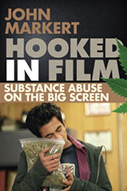Hooked in Film: Substance Abuse on the Big Screen

Author: John Markert
Publisher: Lanham, MD: Scarecrow Press, 2013. 392p.
Reviewer: Bran Nicol | January 2016
This is a fascinating, impressively thorough, and entertaining book. Markert analyzes a vast canon of drug movies from 1960-2010 to show how the message initially conveyed by movies depicting drug use in cinema’s earlier days (1900-1959) became, from the 1960s on, increasingly complicated and multi-faceted. Where initially cinema was instrumental in making viewers aware of the harmful effects of drugs, in more modern times drug use has been presented as far more complex, being either part of everyday life with no serious consequences (i.e. marijuana) or part of a dangerously alluring lifestyle (i.e. cocaine).
What is immediately clear is that the book is the product of an immense amount of research. Its ‘Film Index’ alone makes for thought-provoking reading. With around 400 films it demonstrates in the clearest terms just how common a feature of modern cinema drug use has been. So many films are covered that the book provides the interested reader with a double pleasure: finding out what Markert has to say about movies one already knows well, and discovering others one didn’t know.
The film index is complemented by an excellent sequence of categorized Appendices: 1. Drug Films 1900-1959; 2. Marijuana and Hashish Films 1960-2010; 3. Morphine and Heroin Films 1960-2010; 4. Cocaine and Crack Cocaine Films 1960-2010; 5. Miscellaneous Drug Films 1960-2010. These appendices correspond to the chapters in the book. Following a survey of drug use on screen before the 1960s, there follows four, main chapters each concentrating on the main period in question – one which stretches from the emergence of a drug subculture as part of the 1960s counterculture to the myriad socio-economic problems associated with the explosion of methamphetamine production and use in the last decade or so. Rather than foregrounding issues of social history or genre, the book is therefore organized according to the representation of specific drugs: marijuana, heroin, cocaine, then more miscellaneous recent substances, such as hallucinogens, Ecstasy, and methamphetamines. This approach nevertheless has the effect of providing a more implicit social history of drug use. Crack cocaine, for example, emerged in the 1980s, and can consequently be seen on screen at this time.
Markert’s wager in Hooked in Film is that ‘[m]ovies may play an even more important role than news stories in relating information about drug use.’ Where stories in the media jostle for attention with numerous others, sandwiched in the bulletin sequence, viewers select particular films because they want to watch them. The nature of the cinematic apparatus means they then give them their full attention. The book’s perspective is ‘social constructionist.’That is, Markert’s aim is to trace ‘the evolution of social problems to appreciate how the problem has emerged, been framed by involved parties, and entered the public sphere.’ More precisely, he examines ‘why certain illegal substances emerged as an issue when they did, but also how attitudes have changed over time.’
This means the book skirts close to that dangerous trap for academics: the famous – and famously fatuous – argument beloved of the news media, that watching films has a simplistic trigger-effect on social behaviour. Movies are often central to ‘crime panics,’ such as those surrounding ‘going postal.’ When it comes to drugs in the movies, however, proving that the notion of a simple trigger-mechanism is too crass becomes more complex because, as Markert shows, there can be no doubt that some films ‘convey a positive aura’ surrounding drug use. It is to his credit that he tackles the issue head on, in lucid prose (which means that the book’s appeal is not simple for an academic community). He insists that ‘[m]ost fiction is taken as just that – fiction’ (194). He quotes with approval Joel Black’s remark that films ‘could be mistaken for the real thing only by viewers who are either mentally incompetent or culturally illiterate.’
The social constructionist perspective on cinema, however, also carries with it a danger. What Markert describes in his Introduction as the systematic ‘content analysis’ of films (which I presume means watching them) can give a rather dry impression of what I think is in fact a complex business: enjoying films. Cinema can appear as little other than social reflection – i.e. the book flirts with the implication that we go to watch movies because they reflect what interests us in the wider social world. In his brief analysis of Breaking Bad (which I was pleased to find in the book, sensibly extending beyond its ‘big screen’ remit to take in this influential series) Markert concludes: ‘Suffice it to say that the series shows how becoming involved in criminal activity, no matter what one’s social background and despite the justification, leads towards a darker life’ (271). There is much more to Breaking Bad than this. I think the aesthetics of cinema and how films command viewers to enage with them is more complex as well. One of my favourite quotations from the cultural theorist Slavoj Žižek is his description of ‘ordinary, commercial cinema’ as today’s equivalent of dreams in Freud’s day, the ‘royal road’ to the unconscious. Just as the dream is a coded expression of desires and anxieties in the individual unconscious, so the films we watch are evidence of what is submerged in the collective mind.
That said, in fact, Markert’s concise analyses are on the whole pithy, witty, and accurate, and his book manages to be an important study of a nearly ubiquitous but under-explored area of modern cinema as well as a valuable contribution to the social-constructivist analysis of cinema.
Bran Nicol, Professor of English Literature, University of Surrey, UK


